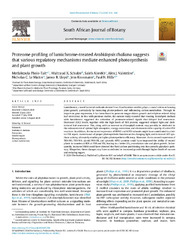| dc.contributor.author | Pholo-Tait, Motlalepula | |
| dc.contributor.author | Le Maitre, Nicholas C. | |
| dc.contributor.author | Lloyd, James R. | |
| dc.contributor.author | Kossmann, Jens | |
| dc.contributor.author | Hills, Paul N. | |
| dc.contributor.author | Schulze, Waltraud X. | |
| dc.contributor.author | Saleh, Alseekh | |
| dc.contributor.author | Valentine, Alex J. | |
| dc.date.accessioned | 2024-10-07T09:12:17Z | |
| dc.date.available | 2024-10-07T09:12:17Z | |
| dc.date.issued | 2024-09 | |
| dc.identifier.citation | Pholo-Tait, M., Schulze, W. X., Alseekh, S., Valentine, A. J., Le Maitre, N. C., Lloyd, J. R., ... & Hills, P. N. (2024). Proteome profiling of lumichrome-treated Arabidopsis thaliana suggests that various regulatory mechanisms mediate enhanced photosynthesis and plant growth. South African Journal of Botany, 172, 515-528. | en_US |
| dc.identifier.issn | 02546299 | |
| dc.identifier.uri | 10.1016/j.sajb.2024.07.036 | |
| dc.identifier.uri | https://www.journals.elsevier.com/south-african-journal-of-botany | |
| dc.identifier.uri | https://hdl.handle.net/13049/752 | |
| dc.description | The article was published under CC BY-NC-ND 4.0 licence. | en_US |
| dc.description.abstract | Lumichrome, a novel bacterial molecule derived from Sinorhizobium meliloti, plays a crucial role in enhancing plant growth, particularly by increasing photosynthesis and influencing carbon metabolism. Through its impact on gene expression, it has been found to promote turgor-driven growth and ethylene-related delay leaf senescence. In line with previous studies, the current study revealed that treating Arabidopsis thaliana with lumichrome suggested the activation of jasmonate-related signals that delayed leaf senescence. Decreased AOC2 levels, together with the high levels of ABR protein, suggested delayed light and dark-induced leaf senescence. This, along with an increase in chlorophyll content, may possibly be attributed to the enhancement of optimal light absorption, energy conversion, and electron transfer capacity of active PSII reactions. In addition, the increased expression of MPH2 and ATPD subunits might have contributed to a better PSII repair, maintenance of proper photosynthetic function under changing light, and increased ATP synthase activity, ultimately resulting in higher photosynthesis efficiency. Moreover, the increased expression of TRX-M1, TRX-M4, plastid PRX-IIE, and cytosolic APX1 proteins could have improved the ability of treated plants to counteract ROS at PSII and PSI, leading to a better CO2 assimilation rate and plant growth. Subsequently, increased FBA8 could have directed the fixed carbon partitioning into the cytosolic glycolysis pathway. Altogether, these changes may have contributed to increased growth through higher levels of sucrose and reducing sugars. | en_US |
| dc.language.iso | en | en_US |
| dc.publisher | Elsevier B.V. | en_US |
| dc.relation.ispartofseries | South African Journal of Botany;172, 515-528 | |
| dc.subject | Arabidopsis thaliana | en_US |
| dc.subject | Carbon metabolism | en_US |
| dc.subject | Photosynthesis | en_US |
| dc.subject | Proteomics | en_US |
| dc.subject | Soluble sugars | en_US |
| dc.title | Proteome profiling of lumichrome-treated Arabidopsis thaliana suggests that various regulatory mechanisms mediate enhanced photosynthesis and plant growth. | en_US |
| dc.type | Article | en_US |

